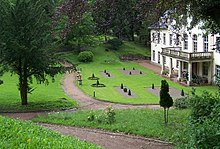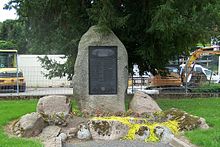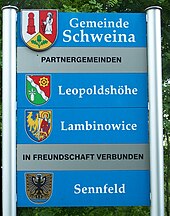Schweina
|
Schweina
City of Bad Liebenstein
|
|
|---|---|
| Coordinates: 50 ° 49 ′ 40 ″ N , 10 ° 20 ′ 19 ″ E | |
| Height : | 305 m |
| Area : | 16.4 km² |
| Residents : | 2946 (Dec. 31, 2011) |
| Population density : | 180 inhabitants / km² |
| Incorporation : | December 31, 2012 |
| Postal code : | 36448 |
| Area code : | 036961 |
|
Location of Schweina in Bad Liebenstein
|
|
Schweina is a district of the town of Bad Liebenstein in the Wartburg district in Thuringia .
geography
Schweina is located in the north-western Thuringian Forest , which is characterized by steep mountains and mixed forests . The Rennsteig running to the north attracts many visitors every year.
The hamlet of Schweina includes the small settlements and settlement parts Glücksbrunner Werke , Profisch , Marienthal and Glücksbrunn .
history

prehistory
A small group of barrows at the Kissel hunting lodge and archaeological finds that were made as early as 1860 during the uncovering of part of the Altensteiner cave suggest that this area was settled early.
According to traditional tradition, the spread of Christianity in this part of the Werra valley began in the 7th century by the Anglo-Saxon missionaries Bonifatius and Kilian .
Between the 10th and 16th centuries
The first documentary mention of the Schweina in the king's letter by King Heinrich I took place on June 1, 933. The name of the water "sueinnaha" was interpreted as the brook of the swineherd , who then lived here.
By the 10th century at the latest, “ traveling smiths ” penetrated the area around Schweina and Ruhla , looking for ore above ground, and processed them on site in “forest smiths”. Around 1150 it developed into continuous iron ore mining. An entry in the tax register of Abbot Marquard von Fulda about a delivery of iron bars suggests this.
In Schweina a special cult of Antonius remained alive, in 1183 a "capelle in Sueinaha" in a document from Pope Lucius III. mentioned, for the veneration of saints there is a special parade on December 24th. When the original Breitungen parish was divided up , Schweina received parish rights between 1385 and 1402.
The first noble family of the Lords of Stein built Altenstein Castle and was first mentioned in a document in 1116 with Dudo von Stein . This castle was the center of a small deforestation rule that included the present-day villages of Schweina, Waldfisch , Gumpelstadt and Steinbach. Local tradition has produced numerous legends for this family as well. The castle gained great importance due to the increasing traffic on Schweinaer Straße , a very old trade route and pass road over the Rennsteig from Franconia to Innerthuringia, which also connected the cities of Erfurt and Fulda . In the 12th century, the Altenstein castle and rule passed to the von Frankenstein dynasty , who were in the service of the Hersfeld Imperial Abbey and exercised the administration and jurisdiction of the town.
Copper mining revived in the village by the 15th century at the latest . 1441 already mentioned 14 smelting works. From 1490 the place was granted brewing rights. In 1492 the Altenstein office fell as a hereditary male fief to the family of the dog from Wenkheim . In 1513 the church of St. Laurentius was consecrated in honor of St. Lawrence . In 1523 Schweina was granted market rights , which it did not use. The introduction of the Reformation was completed in the Altenstein office by 1547. In 1557, a dispute over “staff justice” that had lasted over three hundred years began.
From the 17th century to the end of World War II
During the Thirty Years' War , the mines and official villages suffered from looting and pillage, so on December 17, 1637 the church fell to rubble by plundering Croatian troops. Mining resumed in 1681.
Glücksbrunn Palace was built on behalf of Hofrat Johannes Trier in 1703. At the same time, work began on laying out the Glücksbrunner Park. When cobalt mining began in 1714, a blue paint factory was built . Eberhard Friedrich Hund von Wenkheim (1647–1722) died in 1722 as the last of his family. Thus the Altenstein office went to the Duchy of Saxony-Meiningen, which had existed since 1680 . For 1754, 23 mining pits can be proven. From 1772 to 1776 the region experienced several years of severe famine. From 1798 work began on the construction of the summer residence on the Altenstein by Georg I, Duke of Saxony-Meiningen , which brought more than 300 unemployed miners back into wages and salaries. During blasting work to build the road up to Altenstein, the Altenstein Cave was discovered on June 28, 1799 , and was expanded into a show cave by 1802. In 1824, the first mechanical spinning mill in Schweinas was built in the former blue paint factory by Johann Christian von Weiß , who was ennobled in 1836 and after whom a street in the village is named today. The first steam engine was also used there in August 1827 .
In 1833 the Wenigenschweina estate (also called Minussschweina) was acquired by Duke Bernhard II of Saxony-Meiningen (1800–1882) and renamed Marienthal in honor of his wife Marie von Hessen-Kassel (1804–1888) .
Tobacco pipe production began in 1846 with the establishment of the August Reich & Sons company. In 1850 the pedagogue Friedrich Wilhelm August Fröbel (1782–1852) came to Schweina. Bernhard II made Marienthal Castle available to him to set up the first German kindergarten teacher seminar. In the same year Froebel organized a big game festival on the Altenstein. Friedrich Froebel died on June 21, 1852 in Marienthal Castle and was buried in the Schweina cemetery. From 1870 to 1890 Marienthal Castle housed the " Pedagogy " under the direction of Director Eduard Fischer.
On June 13, 1853, a weekday Monday, the wedding of Prince Albrecht von Prussia (1809–1872), the youngest brother of the Prussian King Friedrich Wilhelm IV. , And his second, morganatic wife Rosalie von Rauch ( 1820–1879). The daughter of the Prussian War Minister Gustav von Rauch had previously been raised to Countess von Hohenau by the Duke of Saxony-Meiningen, who was married to Prince Albrecht's daughter from his first marriage, Charlotte . According to strict guidelines from Berlin, the marriage ceremony, which was inappropriate and vehemently rejected by the Prussian king, had to take place without causing a stir in the smallest of circles. Newspapers were forbidden from reporting.
On May 15, 1887, the new school building (brick school) was officially opened in Schweina. The second new school building was inaugurated on October 9, 1904. In 1908, copper and cobalt mining was finally stopped after the deposits were exhausted.
As a result of the First World War , 132 people from Schweina lost their lives.
On October 1, 1923, the large community of Bad Liebenstein was founded through the merger of Bad Liebenstein, Bairoda, Steinbach , Marienthal and Schweina, which was dissolved again in July 1924. Marienthal became part of Schweina again on April 1, 1937.
During the Second World War had more than 420 prisoners of war from France and military internees from Italy as well as men and women mainly as so-called " Eastern workers " forced labor do: in the spinning mill , in the Holzwarenfabrik Schreinert & Co. , in the chair and Holzwarenfabrik Richard Eick in the company C. & S. Reich and in Marienthal with the companies R. & O. Lux and Gebrüder Heller . Three people were victims of forced labor.
In the Second World War (1939–1945) Schweina had 179 victims; including three dead in a bomb attack in the summer of 1944, in which 154 heavy bombs fell around Altenstein Castle . On February 6, 1945, two American B-17 Flying Fortresses dropped 6.7 tons of explosive bombs over Schweina. On April 5, 1945, the US Army marched into Schweina without a fight. It was replaced by the Red Army on July 6, 1945.
After 1945 until the end of the 20th century
From July 1, 1950 to March 31, 1974, Schweina was part of the Bad Liebenstein community . During this time, Schweina was officially called Bad Liebenstein 2 .
From April 1, 1974, Schweina was again an independent municipality, the Altenstein district remained in the Bad Liebenstein health resort. With the change that began in 1989, all traditional businesses based in Schweina were closed in 1990/1991. In 1990 Schweina officially entered into partnerships with the municipalities of Leopoldshöhe in North Rhine-Westphalia and Sennfeld in Bavaria. On July 1, 1994 the administrative community Schweina / Steinbach was established, within which Schweina is the fulfilling municipality. In 1997 the restored Fröbeldenkmal on the "Fröbelsruh" was inaugurated again. On July 22nd of the same year the Schweina Friedrich-Froebel-Kindergarten was recognized as one of eight official Froebel kindergartens in Thuringia. Another partnership agreement with the Polish municipality of Łambinowice (German: Lamsdorf ) was signed on July 4, 2005.
In the 21st century
In 2000 there were plans to merge Bad Liebenstein, Schweina and Steinbach to form the "Altensteiner Oberland". The merger was initially rejected in a referendum. On November 2, 2011, the mayors of the three municipalities ratified a contract on the formation of a unified municipality . On December 31, 2012, Bad Liebenstein, Schweina and Steinbach merged to form the new town of Bad Liebenstein.
Population development
Development of the population:
|
|
|
- Data source: from 1994 Thuringian State Office for Statistics - values from December 31st
politics
Municipal council
The last municipal council in Schweina consisted of 14 council members.
(As of: local elections on June 7, 2009 )
mayor
Michael Brodführer was appointed mayor in 2013.
coat of arms
Blazon ; "In the shield, which is divided by silver, red and gold in a gopel cut, on the left a red structure consisting of cube, roller and ball (Froebel monument), on the right a silver nimbated saint, in the left hand a silver palm branch, in the right hand holding a black rust St. Laurentius) and below a green oak branch, consisting of two leaves with an acorn in between. "
Partnerships
- Leopoldshöhe , North Rhine-Westphalia
- Łambinowice , Poland
Culture and sights
Associations and traditional events
In Schweina there are more than 30 clubs, such as B. a traditional costume club, the local chronicles, a homeland club, the shooting society or the judo club as well as an audi club or a carnival club. The soccer club organizes the Schweina fair with a particularly rich tradition . Year after year, it attracts numerous guests from the town and the surrounding area.
The torch fire on December 24th
The torch fire on December 24th on the Antoniusberg in Schweina has been a tradition that has been maintained for many years. In historical records of the place it can be read that local swineherd herders celebrated their New Year with sacrificial bonfires at the winter solstice according to Anglo-Saxon custom. They drove their cattle through the ashes of the fire. This should protect the animals from diseases and epidemics. As they rolled down fire wheels into the valley, the new year and the lengthening of the days were welcomed.
In the meantime, however, this ancient custom has changed. Today many individual layers of brushwood are wrapped around a smooth spruce trunk during torch-burning on the Antoniusberg. The tied torches are sometimes up to 9 meters high and are lit in the late afternoon of Christmas Eve. Many thousands of people experience the spectacle year after year. In good weather, the torch fire can not only be seen up close, but also from the Rhön, which is many kilometers away.
Economy and Infrastructure
- industrial Estate
The Mühlweg industrial park is located on the southern outskirts of Schweina, partly on an industrial wasteland. It has a total area of 48.2 hectares (as of 2009).
Personalities
Sons and daughters of the place
- Friedrich Wilhelm August Fröbel (1782–1852) and his second wife Louise Fröbel (1815–1900) buried in Marienthal, Schweina municipality, German educator and founder of the first school for kindergarten teachers in Schweina.
- Effi Biedrzynski (1910–2004), German editor, Goethe researcher and journalist
- Gottfried Müller (* 1934), Minister for Media Policy of the GDR in the cabinet of Lothar de Maizière and later President of the Landtag in Thuringia
- Cornelia Schirmer (* 1968), actress
Personalities who worked in Schweina
- Johannes Walch (1760–1829), superintendent in Schweina
literature
- Eduard Fritze : History about Bad Liebenstein, Schweina, Steinbach and Atterode . Edited by Holger Munkel. Reprint of the Eisenach edition, self-published by the author, 1925. Reprint: Elch Verlag, Bad Liebenstein 1999, ISBN 3-933566-09-6 )
- Roland Geißler : hiking guide to Bad Liebenstein and the Inselsberg. Rockstuhl Verlag, Bad Langensalza 2007, ISBN 978-3-938997-79-6 .
- Hans Zeidler and Heidi Zeidler: The forgotten prince. History and stories about Albrechtsberg Castle . Publishing house of art . Dresden 1995. pp. 112f.
Web links
Individual evidence
- ^ Parts of a chain made of mussel shells - Fritz Kühnemund: Sensational find from the Altensteiner cave . In: Altensteiner Blätter . tape 1999/2000 , pp. 24-27 .
- ↑ NN: Prehistory from the Meiniger Unterland . In: Altensteiner Blätter . tape 1993 , p. 3-5 .
- ↑ Reinhard Albrecht: Traces of the Bronze Age around Altenstein . In: Altensteiner Blätter . tape 1996 , p. 7-10 .
- ^ Emil Rückert: Altenstein's Vorzeit (reprint) . Elchverlag, Bad Liebenstein 2002, ISBN 3-933566-08-8 , p. 5-6 .
- ↑ Manfred Salzmann among others between Ruhla, Bad Liebenstein and Schmalkalden. Berlin 1977, ISBN 3-05-000378-2 , pp. 90-94.
- ↑ Lotar Köllner: Around Ruhla. Erfurt 1993, ISBN 3-7301-0968-5 , p. 9ff.
- ↑ Salzmann (1977) ibid. P. 92.
- ^ Fritz Trautvetter: The parish of Schweina. A historical outline . In: Altensteiner Blätter . tape 1994 , p. 51 .
- ↑ Rückert: ibid . S. 3 .
- ↑ Salzmann (1977) ibid. P. 59.
- ↑ http://www.heimatfreundebali.de/heimatgeschichte/schulen/pädagogium-gymnasium/
- ↑ http://www.heimatfreundebali.de/heimatgeschichte/firmen/firma-ro-lux/
- ↑ Thuringian Association of the Persecuted of the Nazi Regime - Association of Antifascists and Study Group of German Resistance 1933-1945 (Ed.): Heimatgeschichtlicher Wegweiser to places of resistance and persecution 1933-1945. (Local history guide, Volume 8 Thuringia). Erfurt 2003, ISBN 3-88864-343-0 .
- ^ Lothar Günther: Missions and Fates in the Air War over Southwest Thuringia 1944/45 . Wehry-Verlag, Untermaßfeld 2014. p. 322
- ^ Common Oberland: treaty signed. on: insuedthueringen.de November 3, 2011, accessed November 4, 2011
- ↑ Slight majority for 13 new municipalities called on November 27, 2012
- ↑ StBA: Area changes from January 1st to December 31st, 2012
- ↑ Local elections in Thuringia on June 7th, 2009. Elections for community and city council members. Preliminary results. (PDF; 1.9 MB) The State Returning Officer, accessed on February 6, 2010 .
- ↑ Business parks in the Wartburg region. In: Wartburgkreis-Online. Archived from the original on May 15, 2011 ; Retrieved February 18, 2010 .








